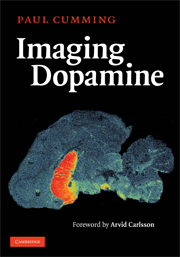Book contents
- Frontmatter
- Contents
- Foreword
- Acknowledgments
- Introduction
- 1 The life history of dopamine
- 2 Enzymology of tyrosine hydroxylase
- 3 The assay of tyrosine hydroxylase
- 4 Enzymology of aromatic amino acid decarboxylase
- 5 PET studies of DOPA utilization
- 6 Conjugation and sulfonation of dopamine and its metabolites
- 7 Dopamine synthesis and metabolism rates
- 8 MAO activity in the brain
- 9 Vesicular storage of dopamine
- 10 Dopamine release: from vesicles to behavior
- 11 The plasma membrane dopamine transporter
- 12 Dopamine receptors
- 13 Imaging dopamine D1 receptors
- 14 Imaging dopamine D2 receptors
- 15 Factors influencing D2 binding in living brain
- 16 The absolute abundance of dopamine receptors in the brain
- 17 Conclusions and perspectives
- References
- Index
- Plate section
17 - Conclusions and perspectives
Published online by Cambridge University Press: 04 December 2009
- Frontmatter
- Contents
- Foreword
- Acknowledgments
- Introduction
- 1 The life history of dopamine
- 2 Enzymology of tyrosine hydroxylase
- 3 The assay of tyrosine hydroxylase
- 4 Enzymology of aromatic amino acid decarboxylase
- 5 PET studies of DOPA utilization
- 6 Conjugation and sulfonation of dopamine and its metabolites
- 7 Dopamine synthesis and metabolism rates
- 8 MAO activity in the brain
- 9 Vesicular storage of dopamine
- 10 Dopamine release: from vesicles to behavior
- 11 The plasma membrane dopamine transporter
- 12 Dopamine receptors
- 13 Imaging dopamine D1 receptors
- 14 Imaging dopamine D2 receptors
- 15 Factors influencing D2 binding in living brain
- 16 The absolute abundance of dopamine receptors in the brain
- 17 Conclusions and perspectives
- References
- Index
- Plate section
Summary
Presenting the life history of dopamine has been a matter of assigning quantities to the arrows depicted in the schematic diagram of Carlsson, introduced over 40 years ago (Figure 1.2). This endeavor has made use of a range of methods, extending from classical enzymology and receptor pharmacology, to modern molecular imaging techniques. All of these methods have been brought to bear on the implicit task of breathing life into a model, with the expectation that garnering enough specific information would allow the construction of an explicit model of dopamine neurotransmission. Needless to say, completion of this task remains to be fulfilled. But after 50 years of dopamine research, enough information has been gathered such that a biological model of considerable complexity can now be defined and constrained, encompassing the main elements of metabolic regulation, compartmentation, and anatomical connectivity of dopamine in the basal ganglia.
The neurochemical anatomy of the basal ganglia has a fine structure; many of its components in human brain are simply too small to be seen with PET. The spatial resolution of PET has dramatically increased in the past quarter century. Thus, it was nearly impossible to resolve the human caudate and putamen in the earliest PET images, which had a spatial resolution of 6–8 mm. Newer tomographs with a resolution of 4 mm allowed the defining of a region of interest encompassing the ventral striatum, which has attracted much attention due to its key importance in the rewarding properties of psychostimulants.
- Type
- Chapter
- Information
- Imaging Dopamine , pp. 229 - 233Publisher: Cambridge University PressPrint publication year: 2009



